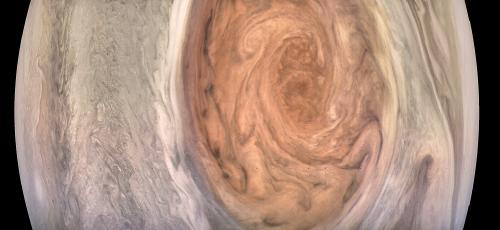Juno
Juno is a NASA spacecraft orbiting the planet Jupiter. It was launched in August 2011 and finally reached Jupiter in July 2016. It has been orbiting the planet ever since. Juno is the second mission to orbit Jupiter; the Galileo spacecraft orbited the planet from 1995 to 2003. The spacecraft is powered by the Sun using large solar panels.
Juno is the only spacecraft which orbits an outer planet to rely on solar power. Usually only satellites which orbit the Earth and the inner planets use it. Juno has three huge panels to generate power for the spacecraft. They need to be large as Jupiter is so far away from the Sun that it's harder to collect light to turn into energy.
Juno's mission is to learn more about how Jupiter formed. It has 8 different instruments on board to take images and run experiments. So far it has discovered lots of things:
- Juno found water in the atmosphere of Jupiter near its equator. Galileo had tried to find this water but failed.
- Juno has also spotted new weather features on Jupiter. New cyclones and lightning in the clouds.
- The spacecraft has found that Jupiter's magnetic field is 10 times stronger than the Earth's.
Photographs of Jupiter's Great Red Spot have been taken by Juno. The spacecraft has found that the storm is shrinking. It is now 1.3 times the size of the Earth, compared to twice the size in 1979. The storm also reaches down far into Jupiter's atmosphere. It is almost 100 times as deep as the oceans on Earth.

Credit: NASA/K Gill

